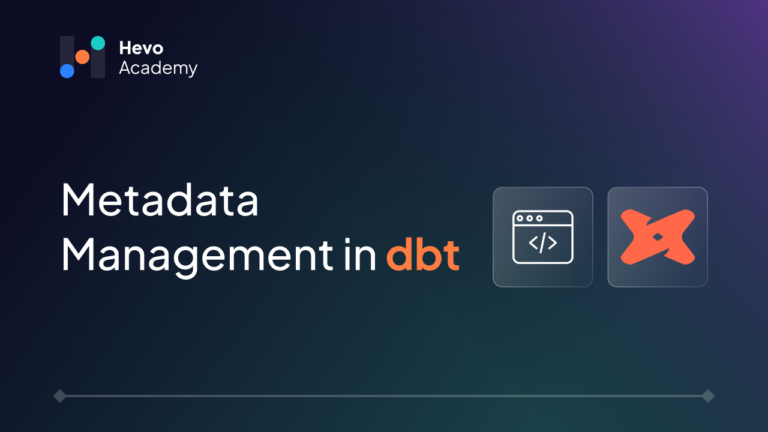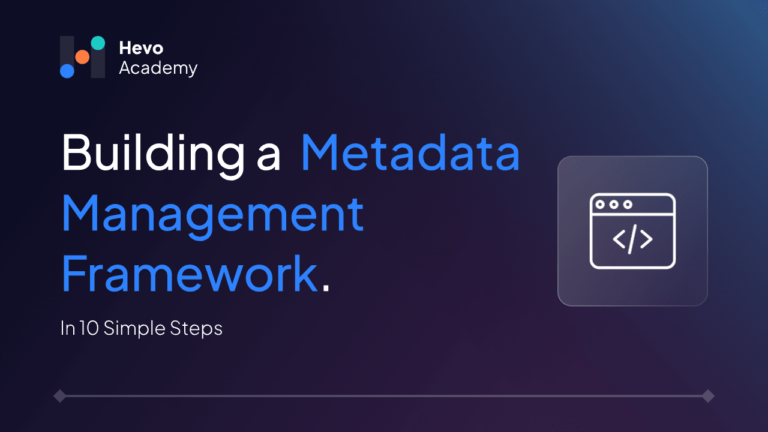Metadata plays a crucial role in managing and understanding data, offering context that enhances its usability and governance. But not all metadata is the same—there are different types, each serving a specific purpose. In this blog, we’ll explore the key types of metadata, providing examples and real-world use cases to show how each one contributes to data management.
Table of Contents
What is Metadata?
Metadata fundamentally refers to “data about data.” It helps us comprehend and analyze facts more successfully by giving descriptions and context. Simply put, metadata allows us to provide meaning to data, which is becoming increasingly appreciated as a valuable resource for businesses, organizations, and individuals. Understanding metadata is essential to engaging with clients, selling products, or analyzing data to predict trends. Effective data management and utilization are crucial for making well-informed decisions and achieving corporate success.
Example of Metadata in Action
An example of metadata in an email includes the recipient’s email address, the subject line, the date and time the email was sent, and the sender’s address. This metadata provides essential context and helps manage and organize emails effectively. A web page stores metadata as meta tags, primarily through HTML tags and attributes. Search engines can use meta tags to comprehend the content of the page better.
Searching for top-tier ETL solutions to unify your data sources? Hevo’s intuitive no-code platform is designed to streamline your entire ETL workflow. With Hevo, your team can:
- Seamlessly integrate data from over 150 sources, including 60+ free options
- Transform data effortlessly using both drag-and-drop features and custom Python scripts
- Ensure robust security with our SOC2 compliant risk management framework for cloud systems
Experience why industry leaders like Ebury, along with 2000+ other satisfied customers, have chosen Hevo over competitors such as Fivetran and Stitch to modernize their data infrastructure.
Get Started with Hevo for FreeCreating Metadata: Manual vs. Automated
Metadata can be created manually or by automated information processing tools. Manual creation allows the user to add any relevant information and is typically more accurate. Automated metadata can be much simpler and typically provides details about the file, such as its size, extension, creation date, and creator. Metadata can be created using various methods, depending on the types of data and the context in which it is used.
Types of Metadata

Metadata comes in various forms, each serving a unique purpose:
- Technical metadata
- Governance metadata
- Operational metadata
- Collaboration metadata
- Quality metadata
- Usage metadata
- Provenance metadata
1. Technical Metadata
Technical metadata provides specific details about the technical characteristics of a data file or a system. It contains information on the hardware or software used, file formats, and other technical details about how the data can be used or processed.
Example of Technical Metadata
Scenario: Digital Image File
Let’s say you have a ‘sunset.jpg’ digital picture file. This image’s technical metadata may consist of:
- File Format: Joint Photographic Experts Group(JPEG), this indicates that the picture was saved in JPEG format, which is popular for compressing the size of photographic images.
- File Size: Provides the size of the image file, which can affect loading times and storage requirements
- Resolution: Specifies the dimension of the image, including quality and details.
- Creation Date: Records when the image is created or last modified.
How Technical Metadata is used
Technical metadata plays a vital role in file management by helping to organize and manage files according to their format, size, and other attributes. It facilitates quality assessment by allowing users to evaluate the image’s resolution and color depth. Additionally, technical metadata ensures compatibility by verifying the file format and compression type, ensuring that files can be opened and processed correctly. It also serves as a historical record, providing crucial information about the creation date and details of the image, which is important for archival and documentation purposes.
2. Governance Metadata
Governance metadata is essential for an organization to manage its data assets. It includes details on the standards, guidelines, and practices applied to data management and protection. These are some important features and scenarios of governance metadata.
Example of Governance Metadata
Scenario: Data Policies and Standards for an Organization
- Policy Name: Data Privacy Policy
- Policy Description: Governs the handling and protection of personal data.
- Effective Date: 2023-01-01
- Review Frequency: Monthly
- Key Standards:
- Data Encryption: Required for all personal data.
- Access Controls: Only authorized personnel may access personal data.
Use Case: Governance Metadata ensures data handling practices align with legal and organizational standards.
Critical Aspects of Governance Metadata
- Data Ownership: It contains details about who is responsible for the data and ensures the data management roles are fulfilled.
- Compliance and Regulatory Requirements: Information on how data management practices align with legal and regulatory requirements.
- Data Policies and Standards: Documentation of data standards and policies governing data usage, privacy, and security.
3. Operational Metadata
Operational metadata describes the day-to-day operations of data systems. Unlike other types of metadata that might focus on the data’s content or its governance, operational metadata centers on the “how” of data handling – contains details on job schedules, error handling, system performance, and data processing activities. This information ensures that data operations function smoothly and efficiently by assisting enterprises in successfully managing and monitoring their data environments.
Example of Operational Metadata
Scenario: An investment company, XYZ, processes daily transaction data from its trading systems into its data warehouse through an ETL job for reporting and analysis. Below are the operational metadata details.
- ETL Job Name: ProcessDailyTransactions
- Job Scheduled Time: Daily at 1:00 AM
- Source: TransactionSystemLogs
- Dependencies: NULL
- Transformation Rules: Convert transaction timestamps to CEST, Filter out transactions below a certain value
- Destination: XYZDataWarehouse.Transactions
- Last Run Time: 2022-09-05 01:05:00
- Run-time Duration: 5 minutes
- Error Logs: No errors encountered
- Status: Completed
Thanks to this real-time operational metadata, the data engineers at XYZ Investments keep an eye on the ETL job. They guarantee that transaction data is processed promptly and made available for analysis without delays. Additionally, the metadata aids in quickly spotting possible problems, such as when a project often takes longer than the expected time and requires optimization.
4. Collaboration Metadata
Collaboration metadata includes details about the collaborative processes associated with a document or project. It provides information about who made particular changes when they were made, and what those changes were about. Managing and comprehending the development of collaborative work requires this metadata.
Example of Collaboration Metadata
Scenario: Collaborative Development of a Data Pipeline
Collaboration Metadata Details
- Pipeline Name: SalesETL_Pipeline
- Contributors: Identifies who was responsible for each part of the pipeline development process
- P1: Developed the initial stage for data extraction process
- P2: Created and applied the transformation logics
- P3: Conducted data quality checks, added validation steps and deployed the pipeline.
- Version History: Documents the evolution of the pipeline version history, including who made the changes. It helps to track the progress and improvements over time.
- Version 1.0: Initial design and extraction logic by P1 on 2022-08-15
- Version 1.1: Transformation logic added by P2 on 2022-08-20
- Version 1.2: Data quality checks and pipeline deployment by P3 on 2022-08-25
- Access Controls: Ensuring team members have the appropriate level of access based on their role.
- Editors: P1, P2, P3
- Viewers: Data Analysts, Project Managers
5. Quality Metadata
The information that characterizes data quality inside a system is called quality metadata. It includes metrics and indicators related to data accuracy, completeness, consistency, reliability, and timeliness. Quality Metadata helps organizations maintain the quality of their data, ensuring it meets the specific guidelines (Governance Metadata) and requirements for analysis.
Example of Quality Metadata
Scenario: Customer Data Management
- Data Accuracy: Measure how close the data matches the true value. High accuracy denotes that data is error-free.
- Accuracy Rate: 98%
- Last Validation Date: 2022-02-15
- Data Completeness: Indicate whether all the required data present, which is essential for analysis
- Percentage of Missing Values: 2%
- Fields Checked: Email, Phone Number, Address
- Data Consistency: Assesses whether data follows schema
- Consistency Check Results: No discrepancies found
- Consistency Rules Applied: Standardized email format
- Data Reliability: Data’s authenticity and accuracy
- Data Timeliness: Evaluates how up-to-date data is and how frequently it is updated.
- Last Update Date: 2022-03-10
- Update Frequency: Monthly
6. Usage Metadata
Usage Metadata records the specifics of how users and systems interact, access, and use data. This Metadata type provides information on data access, patterns, how often the data is used, and user interactions. By providing these insights, usage metadata becomes a crucial tool for understanding data consumption, system performance optimization, and improving the overall user experience.
Example for Usage Metadata
Scenario: Daily Sales Data Pipeline
- Pipeline Name: DailySalesETL_Pipeline
- Data Element: Transactions Table
- Access Frequency: Tracks on how often different user roles access the data elements.
- Data Analysts: Accessed 250 times per week
- Sales Managers: Accessed 150 times per week
- Most Frequently Queried Fields: This captures the specific metric or any particular field within the data element that is most frequently queried or viewed. It helps prioritize the optimization.
- Transaction Amount: Queried 150 times per week
- Store Location: Queried 80 times per week
- Last Access Date: 2022-08-05
- Peak Access Times: 9:00 AM to 11:00 AM
Analyzing how data is accessed and utilized can enhance system performance, tailor user experiences, and drive more informed decisions.
7. Provenance Metadata
Provenance metadata provides origin, history and modification record of data. It records every stage of a data’s lifecycle, from its original creation or any modification the data goes through to reach its final state. This metadata helps in understanding where data comes from, how it has been modified, and the context in which it has been used, making it essential for data quality, traceability, and trustworthiness.
Example of Provenance Metadata
Scenario: E-commerce Platform Data Pipeline
- Data Set Name: SalesData_2024
- Original Data Source:
- Source: Online Sales Transactions.
- Data Transformation History: This provides the information of all the changes made to the data, including the cleaning, aggregation and integration.
- Transformation 1: Data Cleaning
- Date: 2022-03-12
- Performed By: Data Engineer: P1
- Details: Removed NULL vales, standardizing a data format.
- Transformation 2: Aggregation
- Date: 2022-03-13
- Performed By: Data Engineer: P2
- Details: Aggregated sales data by region and product for sales purpose.
- Data Integrity Checks: Consistency verification
- Performed By: Quality Assurance Team
- Details: Verified that aggregated sales data matched expected totals.
Provenance metadata must be integrated into data management procedures to preserve data integrity and openness. By monitoring the complete journey of data from origin to its current state, we ensure that data remains reliable.
Conclusion
Metadata is a powerful tool that transforms raw data into a meaningful assets. By understanding and leveraging the various types of metadata, businesses can unlock deeper data insights, optimize performance and profitable decisions. Exploring the metadata can bring a new approach to data management and analysis. Dive into the essentials of metadata and see how it can empower your data-driven strategies, drive efficiency, and ensure data excellence in today’s data-centric world.
Schedule a personalized demo with Hevo for smooth and seamless data integration.
Frequently Asked Questions
1. Which Types of Metadata Are Most Important To Data Teams?
The most important types of metadata for data teams include technical metadata (data structure, schema, and lineage), business metadata (data definitions and context), and operational metadata (data usage, performance, and access logs). These help teams ensure data accuracy, governance, and efficient workflows.
2. How can metadata improve data management and decision-making?
It can be improved by providing a detailed description of data attributes such as origin, formats, and usage. This helps the data team organize and assess the data more effectively.
3. How does metadata contributes to data security?
Governance metadata ensures that data handling practices comply with policies and regulations.
4. What roles does metadata play in data analytics?
Essential context about the data, including its usage, structure, and origin, is provided. It helps the data analyst to understand the data relationship, perform analysis and drive insights.





